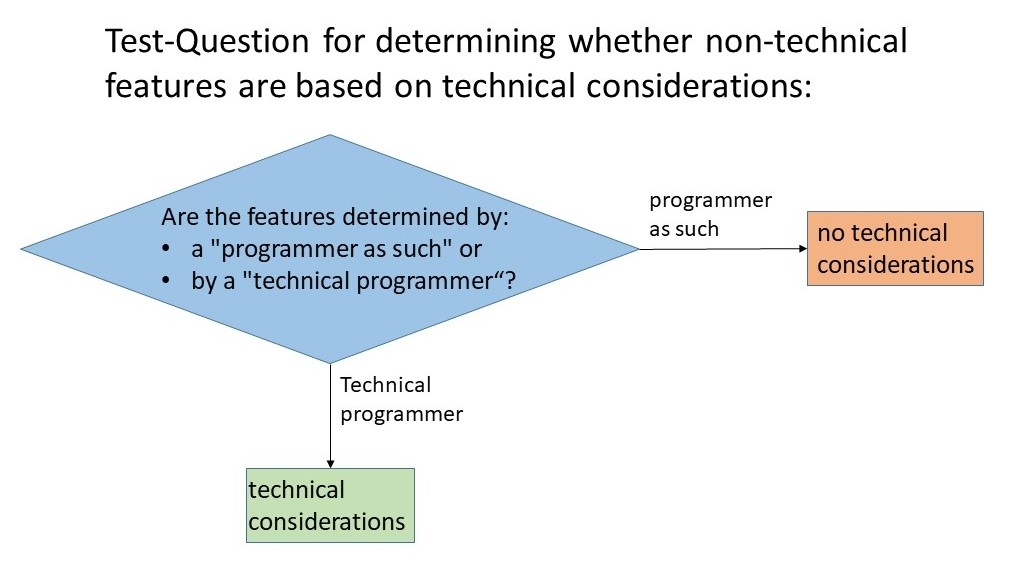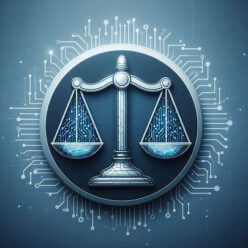So that the non-technical features are considered regarding the inventive step a technical interaction between non-technical features and the technical subject matter of the claim is necessary resulting in a technical effect. Technical effects can occur within the computer-implemented process. This decision – cited in the G1/19 – comprises a list of examples and references to relevant board decisions regarding adaptations to the computer or its operation, which result in technical effects.
Program performance improvements
Some decisions have held that in certain circumstances program performance improvements may be unsuitable for distinguishing between technical and non-technical features, and that technical character is assessed without regard to the prior art.
Example: According to T 1784/06 of 21 September 2012 (which cites T 1227/05): "[e]nhanced speed of an algorithm, as compared to other algorithms, is not sufficient to establish a technical character of the algorithm" (T 1784/06, reasons 3.1.2).
Example: Decision T 2230/10 of 3 July 2015 (reasons 3.6) reads: "the determination of the claim features which contribute to the technical character of the invention is made, at least in principle (the question may in practice be left open for features which anyway are part of the closest prior art), without reference to the prior art (see T 154/04, supra, as explained in T 1358/09 of 21 November 2014, reasons 5.4). That the claimed invention might achieve better results than the method of document D1 is therefore in itself not an indication that the algorithmic modification is technical, although it may be important in the assessment of inventive step once technicality has been established. Technicality is hence more about control of technical parameters than about improvement."
Technical effects over the prior art in the process of determining which features make a technical contribution
The proposition that the issue of “contributing to the technical character” may be determined without reference to the prior art does not imply that technical effects over the prior art never play a role in the process of determining which features make a technical contribution.
The Board in this decision (T 697/17) considered in T 817/16 of 10 January 2019 (reasons 3.12) that “if non-technical claim features interact with technical claim features to cause a physical effect over the prior art, such as an effect on memory usage in a general-purpose computer, the physical effect is to be regarded as a technical effect for the purpose of assessing inventive step if the non-technical features are based on technical considerations aimed at controlling that physical effect (see e.g. decisions T 2230/10, reasons 3.8; and T 2035/11 of 25 July 2014, reasons 5.2.3)”.
In addition, since a non-technical feature can only be considered to make a technical contribution if it interacts with the technical features of the invention to solve a technical problem, bringing about a technical effect, it is legitimate to establish the technical contribution of a feature by analysing the effect caused once it is added to the other features of the invention. Decision T 336/14 of 2 September 2015 affirms that “in the assessment of whether or not a feature provides a technical contribution, the feature shall not be taken by itself, but its technical character shall be decided by the effect it brings about after being added to an object which did not comprise that feature before” (reasons 1.2.2, referring to T 119/88, OJ EPO 1990, 395, reasons 4.1).
Are technical effects like execution time, processing speed, etc. recognized?
With regard to the role of program performance improvements in distinguishing between technical and non-technical features, the Examining Division’s (against the appeal in this case has been lodged) a priori reluctance to recognise some effects as technical is not convincing. The Board in this decision (T 697/17) has the opinion that from none of the above cited decisions it can be concluded that:
- execution time,
- processing speed,
- latency,
- amount of memory required, or
- other such program performance measurements
are per se non-technical measurements which cannot play a role in establishing a technical effect and determining whether a technical contribution is present. The above cited decisions merely teach that an improvement with regard to one of those performance measurements alone (“the sole”, “not sufficient”, “in itself”), is insufficient to establish technical character. In order to decide whether such an improvement is a technical effect it has to be further determined how the improvement is achieved, for instance whether it is the result of technical considerations (T 258/03, reasons 5.8; T 1358/09, reasons 5.5) regarding the functioning of the technical context of the invention (e.g. computer, system, process, transmission channel). Features that purposively use technical means to achieve such an improvement are technical.

In other words, features make a technical contribution if they result from technical considerations on how to for instance improve processing speed, reduce the amount of memory required, improve availability or scalability, or reduce network traffic, when compared with the prior art or once added to the other features of the invention, and contribute in combination with technical features to achieve such an effect (see also T 1924/17, reasons 21 to 22). In particular, the Board in this decision (T 697/17) considers that such an effect on computing efficiency corresponds to a physical effect mentioned in the above-cited passage of decision T 817/16, reasons 3.12, or a change in a physical entity within the meaning of T 208/84, reasons 5 and 7 (see also interlocutory decision T 489/14, OJ EPO 2019, A86, reasons 11).
On the other hand, such effects and the respective features are non-technical if the effects are achieved by non-technical modifications to the underlying nontechnical method or scheme (for example, a change of the business model, or a “pure algorithmic scheme”, i.e. an algorithmic scheme not based on technical considerations).
Furthermore, a change in the quality of a program in terms of the user preferences or other subjective criteria in principle do not give indications of a technical contribution. For example, decision T 598/14 of 6 November 2014, reasons 2.4, did not recognise query enhancement (meant as modifying the original user query to obtain semantically “better results”), as a technical effect because it relied on a semantic distinction and the concept of “better search” was subjective in the context of retrieval based on semantic similarity.
Test for determining whether non-technical features are based on technical considerations
A possible test for determining whether non-technical features are based on technical considerations is to consider whether the non-technical features would have been formulated by a technical or by a non-technical expert (T 817/16, reasons 3.12). Since computer programming involves technical and non-technical aspects (G 3/08, reasons 13.5.1; T 1463/11 of 29 November 2016, reasons 21), it is difficult to apply that test to distinguish abstract algorithmic aspects from “technical programming” aspects. In that case, the test would have to be whether the features were determined by a “programmer as such” or by a “technical programmer”, please see figure below. It may therefore be preferable to directly determine whether the decision to adopt the nontechnical features is a technical one (T 1463/11, reasons 21) or whether it required “technical considerations beyond ‘merely’ finding a computer algorithm to carry out some procedure” (G 3/08, reasons 13.5).

Decisions on non-technical features contributing to the technical character
Several decisions of the boards of appeal have considered subject-matter or features which on their own are excluded to nonetheless contribute, in combination with technical features, to the solution of a technical problem bringing about a technical effect. In some of those cases, the relevant technical effect corresponded to one of the above-mentioned efficiency measures.
According to decisions T 650/13 and T 107/87, a compression algorithm contributes to the technical character of the claimed compression method if it is used for the purpose of reducing the amount of data to be stored or transmitted (T 650/13, reasons 6.3 and 6.4; T 107/87 of 26 April 1991, reasons 3).
Decisions T 1003/09 and T 1965/11 considered that the cost-based optimisation of a query in a relational database system normally had technical character (T 1003/09 of 29 April 2015, reasons 13.3 to 13.5; T 1965/11 of 24 March 2017, reasons 5.1). In particular, decision T 1965/11 found that such a costbased query optimisation searched for low-cost query execution plans using a cost estimate for the computer resources (such as CPU, main memory or hard disk) needed to execute a query plan, and therefore involved further technical considerations relating to the internal functioning of the computer system (T 1965/11, reasons 5.1 and 5.3).
Even though data structures used to store cognitive data are not considered to contribute to the technical character beyond the mere storage of data, data structures used for functional purposes are considered to contribute to producing a technical effect (see e.g. T 1194/97, OJ EPO 2000, 525, reasons 3.3 or T 424/03 of 23 February 2006, reasons 5.2).
In decision T 49/99 of March 2002 the deciding board ruled that information modelling was a non-technical intellectual activity, but that the purposive use of information modelling in the context of a solution to a technical problem could contribute to the technical character of an invention (reasons 7).
An object table used for storing “a system catalog supporting the technical functions of the database system” had technical character (reasons 8 to 10).
In decision T 1351/04 of 18 April 2007, an index file used for the purpose of controlling the computer “along the path leading to the desired data” was considered to contribute to the solution of a technical problem (reasons 7.2).
In decision T 1902/10 of 21 June 2016, a RAM-based hash table of fingerprints of stored URLs was used, in the context of web crawling, to determine whether a URL already existed in a database of processed web pages. The hash table was considered part of the solution to the technical problem (reasons 19 to 22).
In decision T 2539/12 of 18 January 2018, search indexes used to provide access to stored data were considered to contribute to the technical character of the claimed method (reasons 5.5).
And in decision T 2330/13 of 9 May 2018 the specific choice of the claimed bit strings and matrices and respective operations was considered to be determined by technical considerations concerning how to efficiently perform in parallel the steps of a method for evaluating selection conditions, and hence was considered to contribute to the technical character of the claimed invention (reasons 5.7.9 to 5.8).
